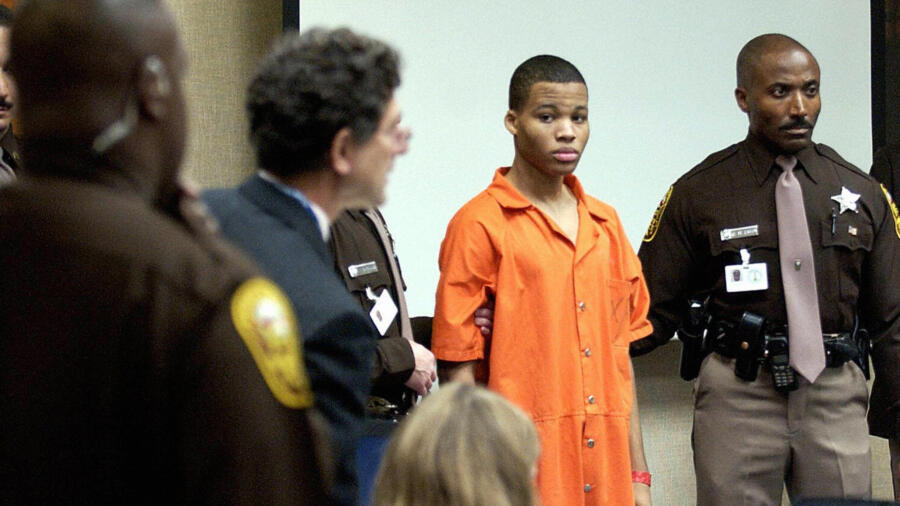This article was originally published on October 3, 2019. It includes updates at the end.
There are at least two ways to view convicted murderer Lee Boyd Malvo. There’s the cold, calculating trigger man who laughed about killing people during a two-month reign of terror in the Washington, D.C. area. And then there’s a teen abandoned by his family, and brainwashed by a violent father figure, who turned him into a “monster” at age 17.
Both sides of the now 34-year-old convicted in the 2002 sniper attacks that killed 10 people will be evoked October 16, 2019 in a resentencing hearing before the U.S. Supreme Court.
John Allen Muhammad, the younger man’s mentor and mastermind of the massacre, was executed in 2009 at age 48.
Malvo was spared the death penalty because of his youth and sentenced to life in prison without parole in Virginia and Maryland.
[Malvo’s case was the subject of an episode of Kids Behind Bars: Life or Parole. Stream now on the A&E website or apps.]
At issue before the Supreme Court is whether Malvo’s Virginia sentence can be reconsidered after changes to rulings regarding juvenile criminals. Defense attorney Craig Cooley tells A&E True Crime his client has changed. “He’s very bright,” he says, “and he’s matured a lot now that he’s no longer under the influence of Muhammad.”
Given his multiple convictions, however, experts say it’s unlikely he’ll walk free.
“This kid just looked at you with blank eyes that had no soul,” former Maryland State Police Lt. David Reichenbaugh, a key investigator in the case, recalls about Malvo’s capture. “He’s not someone you should ever let walk the streets.”
Five Bullets
Paul LaRuffa, 58, was leaving his Clinton, Maryland restaurant late on September 5, 2002, when bullets sprayed him.
“I was on life support for three days,” LaRuffa tells A&E True Crime. “Both my lungs collapsed when all five bullets hit me.” He recovered relatively quickly but, “the mental anguish was just incredibly bad for a couple of months.”
The attack was considered isolated until the murders started spiraling October 2, 2002. That evening, federal program analyst James D. Martin, 55, walked out of a Wheaton, Maryland grocery with snacks for schoolchildren he mentored. He was downed by a bullet from a powerful Bushmaster .223-caliber rifle and died.
On October 3, five people were picked off with mathematical precision in the Maryland suburbs and Washington, D.C.
James L. “Sonny” Buchanan, 39, a poet and a landscaper, was out cutting grass when he was shot and collapsed with a fatal chest wound.
Cab driver Premkumar Walekar, 54, was killed with a single shot as he filled up at a gas station.
Cleaner Sarah Ramos, 34, took a bullet to the head as she read on a bench, waiting for a ride.
Mom Lori Ann Lewis-Rivera, 25, was vacuuming her preschooler’s mess from their minivan when she died.
Handyman Pascal Charlot, 72, was preparing to cross the street when a shot rang out, ending his life.
Father Figure
Who were the men creating terror across two states? John Allen Muhammed was born in New Orleans, the father of four, and a Gulf War veteran.
He was a mechanic, a Karate teacher, a Baptist who became a Muslim and had ended two troubled marriages.
Malvo, a native Jamaican, met Muhammad two years before the Beltway murders in Antigua. The older man had a charismatic appeal for Malvo, who told psychiatrists his mother left his father when he was 5 and allegedly abused him.
Mother and son came to the U.S. in 2000 with Muhammad’s help. When his mother took off, Muhammad assumed the role of parent, giving the teen books about racism in America, and taking him to a shooting range, experts who interviewed Malvo testified.
Malvo viewed Muhammad as his father, psychiatrist Neil Blumberg tells A&E True Crime, “and came to the point he would do anything for him.”
Closing In
By mid-October 2002, the Washington region resembled a ghost town with quiet streets and families hunkering down, remembers Reichenbaugh, then Maryland State Police criminal intelligence operations commander.
“It shook me. As a law enforcement officer, you’re supposed to protect the citizens and [instead] citizens are living in fear,” he tells A&E True Crime.
As police chased leads, the snipers took more lives in Virginia and Maryland suburbs near Washington.
Engineer Dean Harold Meyers, 53, was hit by a bullet as he bought gas October 9.
Businessman Kenneth Bridges, 53, of Philadelphia was shot at a service station October 11.
FBI intelligence analyst Linda Franklin, 47, was killed in a home repair store parking lot October 14.
The final victim, bus driver Conrad Johnson, 35, died on the job October 22.
Two days later, SWAT officers and police converged on the snipers sleeping at a Maryland rest stop.
When police hauled Muhammad out of the car, “he was scared,” Reichenbaugh recalls. “He was completely intimidated and submissive.”
But his younger partner, then 17, was eerily stoic, says Reichenbaugh, author of In Pursuit: The Hunt for the Beltway Snipers. “There’s a lot of stuff about him being manipulated by Muhammad. I don’t buy it for one second. If he could have got out of the handcuffs, he would have killed everyone there.”
Vulnerable or deliberate?
“A vulnerable child lost in the clutches of a madman,” is how Cooley defined Malvo during his 2003 murder trial, noting that exposure to violent video games desensitized him.
Psychiatrists testified the teen suffered from a dissociative disorder, that he distanced himself from his crimes and would do anything to please his substitute father.
Meanwhile authorities detailed how the snipers converted their 1990 Chevrolet Caprice trunk into a mobile hunting blind with a hole for the rifle cut near the license plate.
From that hiding spot, Malvo took aim at Linda Franklin’s head and pulled the trigger. “I asked him where he shot her. He laughed and pointed to his head,” a detective testified.
Malvo is currently imprisoned in Red Onion State Prison in Virginia and spends most of his time in solitary confinement, Cooley says.
In 2006, at Muhammad’s trial, Malvo accused the older man of turning him into a “monster.”
“He is fully aware of the damage he caused,” Cooley explains. Over the years, Malvo has become “an accomplished poet, an accomplished artist,” he adds. “He’s completed his education.”
‘A Survivor Ever Since’
The Supreme Court ruled in 2012 that juvenile murderers shouldn’t automatically receive life sentences without parole unless “irreparable corruption” is found. That decision was made retroactive in 2016 and has generated multiple appeals. But the state of Virginia is pushing back in Malvo’s case.
“This case involves one of the most notorious serial murderers in recent history,” Virginia Attorney General Mark Herring stated in a court filing.” Malvo committed one of the most notorious strings of terrorist acts in modern American history.”
Victims’ groups argue that no one is considering the rights of the families whose loved ones were slaughtered by the snipers.
LaRuffa says the larger issue is “about resentencing juveniles who were sentenced to life without parole so they will not be doomed for the rest of their lives by law to be in prison. I think there’s value to that.
Personally, “I’ve definitely forgiven [Malvo],” LaRuffa says. “I would be miserable if I held onto the anger I felt in 2002.”
But “people confuse forgiveness with excusing him. I do not excuse him. But it’s about me going on. I was a victim that one day in 2002 and a survivor ever since.”
[Update: On February 24, 2020, Malvo asked the Supreme Court to dismiss his appeal due to a change in Virginia law that now makes him eligible for parole. The law states that anyone sentenced to life in prison as a juvenile and who has served at least 20 years can be considered for early release by the state’s parole board. Malvo, who married wealthy activist Sable Noel Knapp, on March 6, 2020, will now be eligible for parole consideration as early as 2022.]
Related Features:
Watch Full Episodes of ‘Kids Behind Bars: Life or Parole’
The Offenders Behind 3 Court Cases That Changed Lifetime Imprisonment Laws for Juveniles


